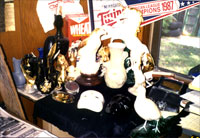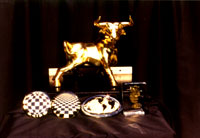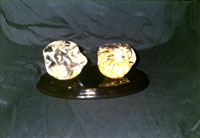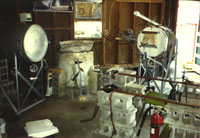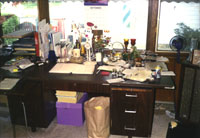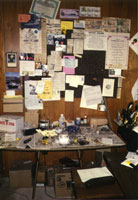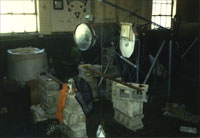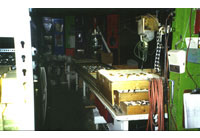Bios

“You want me to give you my life’s savings to start a paperweight factory… and give up all this?”
1984
Graduates from St. Louis Park High School. Barely.
1984-1985
Works for Reis-Targo TV and Appliance [Dad],
clerical and customer service.
Hates it.
1985-1987
Works for Biorkman Furs, sales/clerical/customer service.
Hates it.
1987-1989
Becomes night manager for Just Petites Clothing. Tolerates
it. Barely.
1987-1991
Adds day receptionist/clerical job for the law firm of
Dorfman & Dorfman, Ltd. to her night manager job. Saves
every penny.
1988
Dan says, "You're already working 70 hours a week. That's
all the training you need to be self-employed." Agreeing
to give life's-savings to the new project, she co-founds
Twin City Gilding with Dan.
Parents weep.
1989
Renames Twin City Gilding into
Goldenflow Studios. Changes emphasis from gold
leafing to glass blowing.
Tries glassblowing. Burns self. Tells Dan, "You're doing
the glassblowing!"
1990
Goldenflow Studios moves from a small garage in St. Louis
Park to a leased 85 year-old warehouse space in NE
Minneapolis. Changes emphasis from selling retail through
craft shows to selling wholesale.
Dan rejoices.
1991
Begins a "free sample" campaign based on names hand
copied from business directories found in public library.
Develops a fledgling five-state network of independent
sales reps culled from rep directory she found at local
wholesale gift mart.
Gross sales for 1991 exceed $100,000.
1993
Incorporates Goldenflow Studios into Goldenflow
GlassWorks, Inc., and becomes President of newly formed
corporation. Hits the nationwide wholesale show circuit.
Expands independent sales rep network to cover 75% of
United States. Expands direct marketing efforts and
develops print media sales campaigns.
Gross sales for 1993 exceed $350,000.
1995
Recruits and manages a dozen different independent sales
groups, now covering all 50 states and six foreign
countries. Builds and trains in-house telemarketing team,
plus manages a staff of three clerical processors, four
glass blowers, three glass finishers, three
packaging/shipping workers… and Dan.
Gross sales for 1995 exceed $700,000.
1995 to 1999
As if not having enough to do already (easily bored?),
volunteers for
Eastside Neighborhood Services
as a counselor to help underprivileged people make a
successful transition from welfare to the workforce.
Receives Volunteer Recognition Award in 1998.
1996 to 1997
Volunteers with Person to Person, a mentorship program
designed to help recent immigrants make the adjustment
from public assistance to self reliance.
1997
Rapid growth takes toll on product quality, order
fulfillment and customer relations (not to mention
personal sanity). Dan cries "Uncle." Claims he "Can't keep
up." (Weenie) Begins process of down-sizing Goldenflow
GlassWorks, Inc. Oversees long overdue process of
eliminating unproductive employees, under-performing
product lines, disappointing sales reps, and annoying
accounts. Gross sales drop 35% from peak of $825,000 in
1996, while expenses are dropped by
more than 70%. Manages reduction of studio size from
7,000+ sq/ft to 3,000 sq/ft, staff from 18 to four,
and debt load from $250,000 to $25,000
1997
Joins
Northeast Minneapolis Business Association, helps organize business forum, and solicits forum
vendors.
1999
Elected to board of directors - Northeast Minneapolis
Business Association.
2000
Opens on-site glass art gallery as part of
Goldenflow GlassWorks, Inc. "revival."
Back into direct retail, Dan weeps.
2000
Created the Northeast Minneapolis Arts Retailers' Tour
[ART – get it?], a collection of 40+ local shops,
galleries and restaurants to co-market through print media
and focused distribution of 30,000 group maps/directories.
Generates free media attention.
2001
Appointed to promotions committee -
Central Avenue
Main Street Program.
2001
Appointed to marketing committee - Twin Cities
Marathon.
2001
Appointed to board of directors - Silver Angel Thrift
2001
Not being challenged enough by current route to
Take Over The World, decides to earn her college degree,
after a 17 year absence, starting from scratch. Tells Dan,
"You run things for a while. Don't break it."
2004
Three years of [mostly] full-time school leaves her
longing for the Good Old Days of volunteer work. Joins
Women Venture as a volunteer business consultant and
business class instructor.
2005
Accepts fulltime position working for Women Venture in
their Business Development office. Still teaches classes,
consults, and attends school full-time.
Also, becomes Rollie Reis-Mather.
2006
Graduates Concordia College (Summa Cum Laude) with her
degree in Communications and Organizational Management.
GPA high school: 1.01 - GPA college: 3.97
[Damn Calculus]
Resigns paid position from Women Venture,
though still to this day continues to do volunteer
consulting and teach night classes.
2006
Becomes a business broker for
Calhoun Companies, where she
can be found applying her numerous varied skills to this
day.

"I'm going to be a WHAT!?!?"
I never intended to be an artist.
Pilot? Yes. Inventor? Definitely. Artist?? Puh-leeze!
I spent my high school years tearing apart TVs, radios,
adding machines, anything I could find abandoned curbside
that contained moving or electrical parts. I was in the
Civil Air Patrol for seven years since I was 13 (the
youngest age they allowed in), and for the entirety of my
high school years I focused on getting into the Air Force
Academy after graduating.
My grades could have been better (I hated reading and had
an allergic reaction to homework), so rather than make it
into the AFA I ended up at the University of Minnesota,
AFROTC.
The plan was to get my degree in aerospace engineering,
design futuristic aircraft, and fly for the Air Force. I
was still debating if I wanted to learn to fly the big
transports and eventually get a job flying for a major
airline (dodged a bullet there), or, thinking I'd be just
the right age for when I thought the US would start
sending manned missions to Mars, stick it out and try to
get into the space program.
Unfortunately calculus kicked my ***, hard, and the
reality of signing on the dotted line for ten years while
I was struggling with my studies was too much to
contemplate. So, after a single year of college and ROTC,
I left school.
My first plan, implemented very shortly after my 21st
birthday, took me on a hitchhiking tour of the US. After
bouncing around the country trying to find construction or
oil field work I ended up in Houston (because I hit the
Gulf of Mexico and ran out of land). The idea was to get
myself into some overseas or offshore work and save my
pennies. Unfortunately, in 1982, oil fields were ramping
down, and there was a flood of northern workers rushing
south looking for construction work. By the fall I had
given up trying to find anything that paid and moved back
to Minnesota.
Now, once back at home, the inventor in me began to
develop a line of sportswear based on what I'd seen
runners around Minneapolis wearing (for which I eventually
received a design patent). So I had a bunch of samples
made and flew out to Los Angeles, on a one-way ticket.
Once in LA I found that while shops would try the new line
on consignment, nobody would actually place an order
without knowing how the new line would sell. After several
weeks I ran out of money, and took a bus home.
Historical aside: Two months after I had worked with a
local shop developing my new sportswear line, the same
small shop I worked with began working with a couple of
local wrestlers to develop another new line of sportswear,
making these crazy Zebra print pants. Anyone ever hear of
Zubaz? [Oh, so close.]
I was still hot on the sportswear idea, I just needed to
earn some extra seed money for enough pieces to offer
consignment samples, and try again. So I take a night job
doing micro-assembly at a Control Data plant and a day job
driving a delivery van for a local retail clothing chain
and. Part of the delivery job also involved chauffeuring
the owner on weekends in his limo.
So it strikes me that a faster way to earn that extra
money for my new business venture would be to buy my
boss's old limo and start a limousine service.
["Hey, boss, you need to dump this heap and get a new
limo. Why, sure, I might be interested in taking it off
your hands."]
Most interesting lesson learned:
My new [to me] limo was a Buick Park Avenue, and all the
calls I received on my early ads asked if I had a Cadillac
or a Lincoln to offer. Nobody wanted to rent my Buick
limo. I had dropped my prices to $20 an hour, and still I
could barely book any runs. So, not wanting to just turn
away business (and wanting to stay in business), I called
every limo service in town and asked if I could book runs
into their open limos and recieve a commission. Over half
the companies in town agreed, so in the following year's
Yellow Pages my new ad listed "Lincolns, Cadillacs,
Mercedes, and Rolls Royce limousines available."
Now the most common question asked went from, "Do you have
any Lincolns or Cadillacs?" to, "What's your cheapest
limousine?"
That, of course, was my Buick limousine.
Literally overnight, I went from not being able to give it
away at $20 per hour, to being booked 5-7 days a week at
$35 p/h. (Oddly, I never did make a booking into the Rolls
Royce limo) [My connections running the cities largest
limousine referral service, The Limousine Connection, also
propelled me into elected office as the first president of
the MN Limousine Owners Association, but that's another
story.]
However, the demographics of the limousine business soon
turned sour. Within five years the Twin Cities went from
only a dozen different services to 120 limousine services,
and at the same time people were drinking and partying
less and less. It was time to find something new to
subsidize the ol' income again.
Several years earlier someone had given me a book of gold
leaf that had sat untouched in the back of a desk drawer.
I decided that I could learn some basic gilding and do
gold leafing onto picture frames and statues and such at
home while I manned the phones for my limousine agency.
I had been friends with Rollie for several years at this
point and knew she was a rich source of unsolicited advice
(and had been saving money like mad working two jobs). So
I offered her the chance to put her money where her mouth
was and partner up in this latest of business ventures.
The thought was that I could produce product and she could
work the sales. She actually agreed.
1988: Enter Twin City Gilding.
Several months went by where we built up tools and
supplies, and started gold leafing a variety of objects
(statues, paperweights, silk flower leaves, etc). One day
Rollie looked at the dish of alcohol we used to clean our
brushes and commented on the bits of gold leaf swirling
around in it. "We should find a way to get a glass
something to put that in and make use of our gold leaf
scraps."
Good idea.
We decided to call it a "Goldenflow."
So, off to the library we went in search of a Thomas
Registry. We copied dozens of names of glass manufacturers
and sent out scores of Request For Bids. Two weeks later
and only two responded: No Bid! Apparently nobody wanted
to deal with us unless we were prepared to order 50,000
pieces.
So, off we went now in search of a local glass artist to
produce these things for us. Though we did finally find a
local artist who would make some glass blanks for us, they
were "artists" and as such had no interest in making
quantities beyond 30-40 pieces.
Faced with a production gap of quantities between 50 and
50,000, Rollie and myself, neither of us having ever seen
glassblowing before, signed up for a glassblowing class at
a local community college.
The rest, as they say, is history.
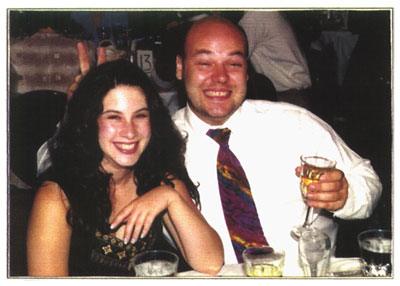
"Yeah, we're married now, but don't tell anyone..."
1988
Became business partners.
1989
Started Goldenflow Studios.
1993
Began dating.
(Moved in together two days later)
2002
Became "officially"
engaged.
[Next day]
Rollie's
mother stops trying to fix her up with Nice Young Men.
2005 (January 29)
Married in
secret ceremony.
2005 (December 25)
Finally told
parents they got married.
2007 (January 28)
Threw wedding
reception party at Jax.
The “Bag Lady” Story
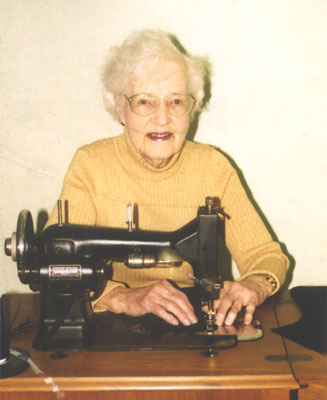
Margaret "The Bag Lady" Goetzenberger
January 7,
1914 - March 25, 2016
In the beginning, the very, very beginning, when we were first making up our earliest Goldenflow samples for Rollie to bring around town and show store buyers, we wanted some kind of a tag or card to put with the Goldenflow telling a little bit about what it was. We decided the best way to achieve this was to have a small velour pouch made and then attach our small tag romance card to the drawstring.
So, of course, I immediately thought of…
my grandmother for this project.
When we originally approached her about making these bags for us, her first immediate question was, "How many bags?" When we told her it might be as many as, um, ahhh, 300 bags she hesitated and told us that she wasn’t sure she could do that many, but would give it a try anyway.
We stopped counting after 500,000 bags.
Margaret, aka "Grandma," who invoiced us as "The Bag Lady," who with the help of a couple extra Bag Lady assistants, became the center of a very prolific micro-business supplier. Margaret continued sewing every velour pouch that came with every Goldenflow piece until she was 100 years old.

"…is like saying, 'It's not the bullet, it's the hole."
Our first public showing of these new gold leaf ball
things is only a few weeks away, our deposit is paid, and
all we have are the three original sample pieces that we
found one artist to make for us a month earlier, before
he'd had enough.(He was an artist, damnit!)
So, after running around the city desperately trying to
find a glass artist, any glass artist, to make some extra
Goldenflow blanks for us, we finally find one at the
University of Minnesota, and all we can get is what we
[he] can make us in the U of M studio in a single session,
on the Saturday before Labor Day.
(The U's studio was closing for summer break the next day)
With me standing on and doing what I can to help, we get
about 30 oddball pieces.
I spent the next week with a grinder, some alcohol (the
denatured kind… mostly), some gold leaf, a very small
funnel, some silicon glue and some brass punches, and in a
race against time as our very first outdoor art show was
rapidly approaching I ground, filled, and sealed our 30
pieces.
On the day of the show the temperature was 102 degrees.
Those of you who paid attention in physics when they
taught fluid dynamics know what happens next.
We, however, didn't see this coming.
Almost as soon as we started putting pieces out on the
display table we started smelling that distinctive rubbing
alcohol smell. Sure enough, the first piece someone picks
up is leaking. Quickly we "hide" that piece under the
table. Then we notice a wet spot under a couple more
pieces.
We soon run out of display pieces to put under the table,
and decide to simply move the leaking ones closer to us so
people can still see them, and put the good ones all
closer to their side of the table where they pick them
up.
Except that before long there were no good ones left.
Total duration of our first show: 90 minutes.
On the way home Rollie was very upset with me for not
starting my sealing experiments earlier in the week. She
had a point, and I could have done more seal testing that
week.
But the sad irony is that it took over six years, more
than 100,000 pieces, and a specially trained adhesives
chemical engineer before we really, finally, learned how
to permanently seal our Goldenflows easily, effectively,
and consistently.
(That's also why we don't worry too much about anyone
copying our idea. Just let 'em try and figure that one
out)
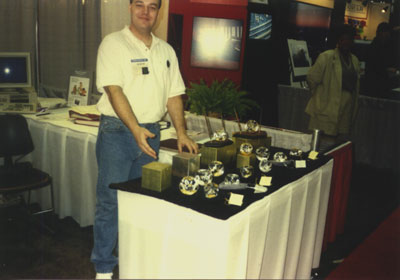
[Only known photo of Dan clean shaven]
After having given up on the craft/art retail fair circuit
(I'll never be able to eat another pronto-pup, ever), and
having some success with Rollie running around town
showing wholesale samples to various gift stores and
jewelers we saw that 12 of our first 18 retailers were
jewelry stores.
Based on this we thought we should
:::ding:::ding:::ding:::ding:::
get a booth in a wholesale tradeshow for jewelers.
So, for our first trade show we chose the Minnesota
Jewelers Association (now the Midwest Jewelers
Association)
being held locally at the Radisson South.
We didn't have much by way of a display.
No backdrop, no fancy tabletops, just $8 in glittery black
fabric draped over our show-provided 2'x 6' table
and a dozen Goldenflows scattered about.
We only had two sizes at first, standard and large, with
our wholesale prices starting at $20. But we wanted to at
least get some sample pieces out into the stores, so we
had this great idea to make "minis," and we figured we
could sell these at the show for $10.
It was halfway through the first day of the show
and we'd only sold a handful of minis, one at a time,
when it hits me. I take out a marker and on our
"Show Special" sign promoting the $10 mini I write:
Limit – 2 per person
Well, that changed everything.
Not only did everyone who stopped by our booth have to buy
a Goldenflow, and not only are they now buying two, but
they were using those staff and friends attending the show
with them to "qualify" for the additional two pieces
per.
Heh.
We went from having made less than $100 in direct sales
before the "limit," to over $1,000 in sales after. And we
picked up a handful of new retailers, too.
It was a very good show.
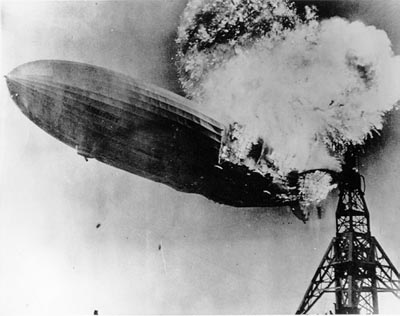
"What could possibly go wrong?"
Flush with the success of a good local show and a handful
of retail accounts, we figured it's time we try our luck
at an out-of-state trade show. We had gotten a lot of mail
from a group called the Helen Brit Shows.
Their literature talked about how many buyers came to
their shows and the pictures all showed rows of exhibitors
and full aisles of customers. It looked like a
no-brainer.
So we decided to register and attend the New Orleans
show.
The only car we had that ran at this point was my old
limo, so we packed it up with cases of product and display
materials, and hit the road.
We hadn't given much thought to hotel reservations when we
left. It's a big city, and we didn't see where it would be
a problem to find a room once there.
Once there we learned that our show just happened to fall
on the same weekend as the New Orleans Jazz Festival.
We might as well have picked Marti Gras week.
So, after searching for what seemed an eternity
(at night, no less) we finally find this seriously seedy
motel
in a frightening area just outside of town.
(I don't remember where it was exactly)
(Future historians will argue over whether I slept in the
limo to protect our products and the car, or because this
was before Rollie and I started dating and we couldn't
afford two rooms.)
- Day of the Show -
We brought into the show about 30 of the 150 pieces we
brought down with us. The crowds were actually good, but
something was wrong. As we collected cards from "buyers"
we started to notice that there were no gift stores. No
Jewelers. No addresses. All these people were "Boutiques."
They all worked out of their homes and only created these
"business cards" to get past the show's stringent
requirement that attendees be "stores." This, we quickly
learned, was how people bought "wholesale" before there
was a Sam's Club and Costco to make us think we were
buying "wholesale."
Talking to the other exhibitors around us we learn that
they're fully aware of the fact they the buyers "think"
they're buying wholesale, that they're not really store
buyers, and that they're really just selling cheap junk
cheaply and calling it wholesale.
Still, we tried to sell something, anything, to anyone.
Nothing. Zip. Nada.
People picked them up and oooed and ahhhed, but nobody was
about to shell out $20 for anything. All day long people
were picking them up and asking, "But what does it do?" I
finally started telling people that they were for weather
detecting. If it gets wet, it's raining. If it blows over,
it's windy.
[Rollie removed me from sales later that year]
It gets better.
So we go back to the limo after a depressing day at the
show, and as I open the door this wall of alcohol vapor
almost knocks me over. This was summertime, in New
Orleans, and the interior of the car must have gotten to
140 degrees. Because of the laws of thermodynamics, of the
120 pieces we left in the car, all but 25 had broken from
the pressure built up when they got so hot in the back of
the limo.
(I consoled myself by saying at least most of the seals
held)
But the best was yet to come.
The next day, about an hour into the show, a show official
comes over to our booth and presents us with the check we
sent them last week for our show fees.
It didn't just bounce; the bank had closed our account.
["Ahhhh, good times…."]
We could pay them cash on the spot, or leave the show.
We took the whopping $20 we made selling a single
Goldenflow to another vendor that morning, and left.
- Silver lining -
While at the show, before being so ignobly dismissed, we
talked to several vendors who did give us some good
referrals to "real" wholesale shows. In fact, the photo of
me at the top of
Our First Trade Show is
actually me at the NY Gift show, sharing a booth with a
lead we met at the New Orleans show. That show, our first
show following the disastrous
New Orleans show, was the show that actually
helped launch our national presence.
I didn't have any pictures from our first trade show,
but that photo of me clean shaven was from the same narrow
time frame (1990) and showed the level of our display at
that original jewelers show.
History
In the beginning.......
Before there was Goldenflow Studios, there was Twin City Gilding, a tiny operation that consisted of Rollie Reis and me, Dan Mather.
(We put gold leaf on stuff while working from my den)
One fateful day in 1989, Rollie noted how nice the gold leaf looked floating around in the dish of alcohol they used to clean their brushes. She thought that if they could put this 23k-laced solution into something, like maybe a glass hourglass, it would be a really cool idea. So off they go to find a glass producer.
After a twisted and depressing search to find someone to make these new glass things (factories wanted 50,000 piece minimums, artists wouldn't do more than a dozen), Rollie and I ended up enrolled into a local community college to learn to blow the glass ourselves.
By the fifth week of class, the instructor (Satan) declared our fledgling artwork "Monkey [expletive deleted]", and their ambitions futile. Undaunted, we left.
Armed with a confidence normally reserved for the delusional, we set about building a small glass blowing studio in the garage, and proceeded to try and finish teaching ourselves to blow glass.
The den served as both office and finishing studio.
And so Goldenflow Studios was born...
As visions of burning down the wood-framed garage kept us up at night, it was soon decided that a more appropriate studio space was needed. Something less combustible, something with a little more brick and mortar. So by February of 1990 we had found a small 300 square foot studio space in NE Minneapolis. At the time 300 feet of space seemed quite large, as it was twice the space the garage had afforded us.
The plan was simple. I would be responsible for the studio, and try to produce as many Goldenflows as I could. Rollie would be responsible for the office, and would try to sell as many Goldenflows as she could. We agreed that what didn't sell would be sent out to stores as samples. So, Rollie and I would go to the local library, photocopy lists of gift stores from business directories, and call them to see who wanted to see a free sample. Simple.
But a funny thing happened. Nobody knew what a Goldenflow was, what it did, or where it should sell. We'd talk to gift buyers and they told us to talk to stationery buyers (because it's a "paperweight"). We talked to stationery buyers and they told us to talk to jewelry buyers (because it's "real" gold). We'd talk to jewelry buyers and they told us to talk to gift buyers (because it wasn't "jewelry"). Just the same, over 1,200 samples went out that first year.
From here we started sending out thousands of postcards telling stores to call us for a free sample. Rollie started displaying at wholesale gift and jewelry shows. She began locating and hiring independent sales reps around the country. I painted the studio and developed finishing systems that could handle more and more production.
But to no avail. By 1995 these distinctive glass and gold snowdomes were selling at a clip of 50,000 pieces a year, popping up in literally thousands of stores, across all 50 states, and worldwide to over 6 (OK... that's not so many, but hey, we weren't even trying) different countries. Our 300 square foot studio had grown in five short years into an unwieldy 4,500 square foot warehouse/studio/office behemoth. We had clearly transitioned into our second worst nightmare.
In spite of now running three furnace stations, five glass blowers, and four glass finishers, I couldn't keep up. For Rollie's part, she was managing a dozen independent sales groups (with more than 60 sales people between them), an in-house telemarketing team of five, and a couple more processing staff. 70 hour workweeks wasn't our idealize vision of success.
As we began to lose control (as if we ever had real control) over staff and systems, both product quality (they started leaking) and customer service ("If I have to field one more 'leaking' call…") began to, um, falter.
Our response was three-fold; bring in a professional adhesives engineer to help us identify and permanently solve the leaking issues, greatly reduce marketing efforts until we were positive the problem was solved once and for all, and reduce staff and return to doing our processes ourselves.
After laying low and otherwise succeeding in these corrective measures, we undertook one more major change; Rollie went back to school to get her business degree. (We figured in a worst-case scenario at least one of us should be employable)
These days Goldenflow Studios is still chugging merrily along, producing more than 15,000 Goldenflows a year. While not as intense as the heady Go-Go days of the mid-90's, the product never looked cleaner, the systems never ran as efficiently, and my days aren't greeted with the fear and loathing that was so common when we were at our peak.
And Rollie, having since graduated [Summa Cum Laude, no less], is currently helping other business owners deal with their own success-fueled nightmares, as well as those who want the kind of success that a 70 hour workweek enjoys, as a business consultant.
